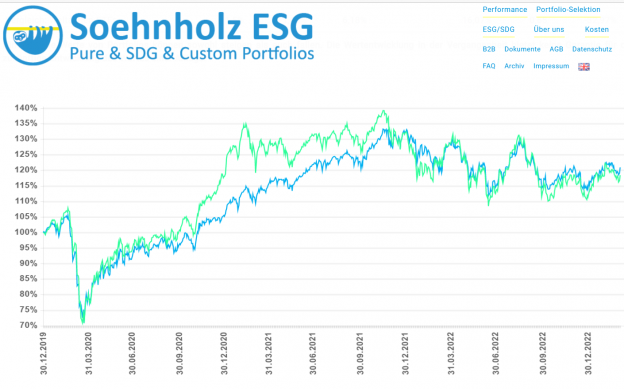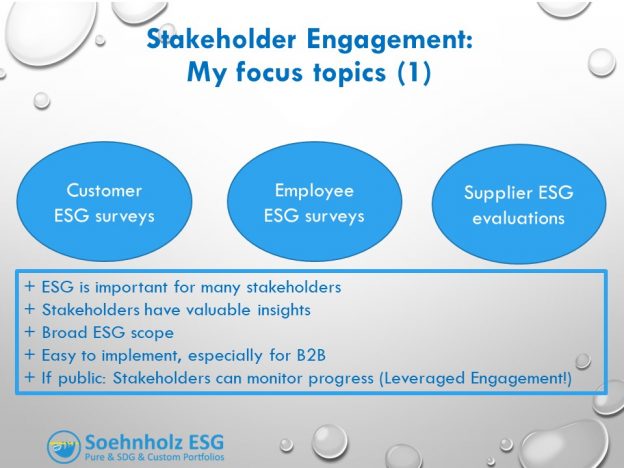Active ESG share: 26x new research on SDG, climate automation, family firms, greenium and green liquidity, anti-ESG, ESG-ratings, diversity, sustainability standards, disclosure, ESG pay, taxes, impact investing, and financial education by Martijn Cremers and many more (#: SSRN downloads as of July 27th, 2023)
Ecological and social research: Active ESG share
SDG deficits: The Sustainable Development Goals Report Special edition by the United Nations as of July 10th, 2023: “At the midpoint on our way to 2030, the Sustainable Development Goals are in deep trouble. An assessment of the around 140 targets for which trend data is available shows that about half of these targets are moderately or severely off track; and over 30 per cent have either seen no movement or regressed below the 2015 baseline. Under current trends, 575 million people will still be living in extreme poverty in 2030, and only about one third of countries will meet the target to halve national poverty levels. Shockingly, the world is back at hunger levels not seen since 2005, and food prices remain higher in more countries than in the period 2015–2019. The way things are going, it will take 286 years to close gender gaps in legal protection and remove discriminatory laws. And in education, the impacts of years of underinvestment and learning losses are such that, by 2030, some 84 million children will be out of school and 300 million children or young people attending school will leave unable to read and write. … Carbon dioxide levels continue to rise – to a level not seen in 2 million years. At the current rate of progress, renewable energy sources will continue to account for a mere fraction of our energy supplies in 2030, some 660 million people will remain without electricity, and close to 2 billion people will continue to rely on polluting fuels and technologies for cooking. So much of our lives and health depend on nature, yet it could take another 25 years to halt deforestation, while vast numbers of species worldwide are threatened with extinction” (p. 4).
Climate automation: Labor Exposure to Climate Change and Capital Deepening by Zhanbing Xiao as of June 21st, 2023 (#31): “This paper looks into these risks and calls for more attention to the health issues of outdoor workers in the transition to a warmer era. … I find that high-exposure firms have higher capital-labor ratios, especially when their managers believe in climate change or when jobs are easy to automate. After experiencing shocks to physical (abnormally high temperatures) or regulatory (the adoption of the HIPS in California) risks, high-exposure firms switch to more capital-intensive production functions. …I also find that high-exposure firms respond to the shocks by innovating more, especially in technologies facilitating automation and reducing labor costs. … industry-wide evidence that labor exposure to climate change negatively affects job creation and workers’ earnings“ (p. 34/35).
Open or private data? Opening Up Big Data for Sustainability: What Role for Database Rights in the Fourth Industrial Revolution? by Guido Noto La Diega and Estelle Derclaye as of Nov. 8th, 2022 (#159): “… the real guardians of big data – the private corporations that are the key decision-makers in the 4IR (Sö: 4th Industrial Revolution) – are not doing enough to facilitate the sharing and re-use of data in the public interest, including the pursuit of climate justice. … While there may be instances where Intellectual Property (IP) reasons may justify some limitations in the access to and re-use of big data held by corporations, it is our view that, in general, IP should not be used to hinder re-use of data to pursue the SDGs. … First, we will illustrate the triple meaning of ‘data sustainability.’ Second, we will critically assess whether the database right (or ‘sui generis right’) can play a role in opening up corporate big data. Third, will imagine how a sustainable framework for sustainable data governance may look like. This focus is justified by the fact that the Database Directive, often accused of creating an unjustified monopoly on data, is in the process of being reformed by the yet-to-be-published Data Act” (abstract).
Clean family firms: Family Ownership and Carbon Emissions by Marcin Borsuk, Nicolas Eugster, Paul-Olivier Klein, and Oskar Kowalewski as of April 13th, 2023 (#159): “Family firms exhibit lower carbon emissions both direct and indirect when compared to non-family firms, suggesting a higher commitment to environmental protection by family owners. When using the 2015 Paris Agreement as a quasi-exogeneous shock, results show that family firms reacted more to the Agreement and recorded a further decline in their emissions. … Firms directly managed by the family experience a further reduction in their emissions. On the contrary, family firms with hired CEOs see an increase in emissions. We show that family firms record a higher level of R&D expenses, suggesting that they invest more in new technologies, which might contribute to reducing their environmental footprint. … Compared with non-family firms, family firms commit less to a reduction in their carbon emissions and display lower ESG scores“ (p. 26).
Green productivity: Environmental Management, Environmental Innovation, and Productivity Growth: A Global Firm-Level Investigation by Ruohan Wu as of June 18th, 2023 (#5): “… overall, environmental management and innovation both increase firm productivity but substitute for each other’s positive effects. Environmental management significantly increases productivity of firms that do not innovate, while environmental innovation significantly increases productivity of those without environmental management” (p. 30).
Good governance: Governance, Equity Issuance and Cash: New International Evidence by Sadok El Ghoul, Omrane Guedhami, Hyunseok Kim, and Jungwon Suh as of May 9th, 2023 (#18): “… we hypothesize that equity issuance is more frequent and growth-inducing under strong governance than under weak governance. We also hypothesize that cash added to or held by equity issuers creates greater value for shareholders under strong governance than under weak governance. Our empirical results support these hypotheses. Most remarkably, under weak governance, cash assets not only fail to create but destroy value for shareholders if they are in the possession of equity issuers instead of non-equity-issuers. Overall, strong institutions help small growth firms unlock their value through active equity issuance. On the flip side, weak institutions render an economy’s capital allocation inefficient by hindering value-creating equity issuance” (abstract).
ESG Ratings Reearch: Active ESG Share
MSCI et al. criticism? ESG rating agency incentives by Suhas A. Sridharan, Yifan Yan, and Teri Lombardi Yohn as of June 19th, 2023 (#96): “First, we report that firms with higher (lower) stock returns receive higher (lower) ratings from a rater with high index incentives relative to ratings from a rater with low index incentives. … Second, the rater with high index incentives provides higher ESG ratings for smaller firms with less ESG disclosure. … Third, we show that ESG index inclusion decisions are associated with stock returns. Collectively, our findings suggest that ESG data providers’ index licensing incentives influence their ESG ratings“ (p. 22).
Anti-ESG ESG: Conflicting Objectives of ESG Funds: Evidence from Proxy Voting by Tao Li, S. Lakshmi Naaraayanan, and Kunal Sachdeva as of February 6th, 2023 (#840): “ESG funds reveal their preference for superior returns by voting against E&S proposals when it is uncertain whether these proposals will pass. … active ESG funds and non-ESG focused institutions are more likely to cast votes against E&S proposals” (p. 26).
Non-ESG ESG? What Does ESG Investing Mean and Does It Matter Yet? by Abed El Karim Farroukh, Jarrad Harford, and David Shin as of June 26th, 2023 (#77): “… even ESG-oriented funds often vote against shareholder proposals related to E&S issues. When considering portfolio holdings and turnover, firms added to portfolios have better ESG scores than those dropped for both ESG and non-ESG funds. Nevertheless, portfolio additions and deletions do not improve fund scores on a value-weighted basis, and those scores closely track the ESG score of a value weighed portfolio of all public firms. This suggests that while investment filters based on ESG criteria may exist, they rarely bind. … we find that material E&S proposals receive more support, but only a small proportion (4%) of these proposals actually pass. Lastly, unconditional support from funds associated with families that have signed the United Nations Principles for Responsible Investing (UN PRI) would lead to a significant change in the voting outcomes of numerous E&S proposals. Overall, our findings suggest that the effects of ESG investing are growing but remain relatively limited. E&S proposals rarely pass, and the ESG scores of funds declaring ESG preferences are not that different from the rest of funds“ (p. 26).
ESG divergence: ESG Ratings: Disagreement across Providers and Effects on Stock Returns by Giulio Anselmi and Giovanni Petrella as of Jan. 23rd, 2023 (#237): “This paper examines the ESG rating assigned by two providers, Refinitiv and Bloomberg, to companies listed in Europe and the United States in the period 2010-2020. … Companies with higher ESG scores have the following characteristics: larger size, lower credit risk, and lower equity returns. The ESG dimension does not affect stock returns, once risk factors have been taken into account. The divergence of opinions across rating providers is stable in Europe and increasing in the US. As for the individual components (E, S and G), in both markets we observe a wide and constant divergence of opinions for governance as well as a growing divergence over time for the social component“ (abstract).
Active ESG share: The complex materiality of ESG ratings: Evidence from actively managed ESG funds by K.J. Martijn Cremers, Timothy B. Riley, and Rafael Zambrana as of July 21st,2023 (#1440): “Our primary contribution is to introduce a novel metric of the importance of ESG information in portfolio construction, Active ESG Share, which measures how different the full distribution of the stock-level ESG ratings in a fund’s portfolio is from the distribution in the fund’s benchmark … We find no predictive relation between Active ESG Share and performance among non-ESG funds and a strong, positive predictive relation between Active ESG Share and performance among ESG funds” (p. 41). My comment: My portfolios are managed independently from benchmarks and typically show significant positive active ESG shares, see e.g. Active or impact investing? – (prof-soehnholz.com)
Responsible investment research: Active ESG share
Stupid ban? Do Political Anti-ESG Sanctions Have Any Economic Substance? The Case of Texas Law Mandating Divestment from ESG Asset Management Companies by Shivaram Rajgopal, Anup Srivastava, and Rong Zhao as of March 16th,2023 (#303): “Politicians in Texas claim that the ban on ESG-heavy asset management firms would penalize companies that potentially harm the state’s interest by boycotting the energy sector. We find little economic substance behind such claims or the reasoning for their ban. Banned funds are largely indexers with portfolio tilts toward information technology and away from energy stocks. Importantly, banned funds carry significant stakes in energy stocks and hold 61% of the energy stocks held by the control sample of funds. The risk and return characteristics of banned funds are indistinguishable from those of control funds. A shift from banned funds to control funds is unlikely to result in a large shift of retirement investments toward the energy sector. The Texas ban, and similar follow-up actions by Republican governors and senior officials, appear to lack significant economic substance“ (p. 23).
Better proactive: Gender Inequality, Social Movement, and Company Actions: How Do Wall Street and Main Street React? by Angelyn Fairchild, Olga Hawn, Ruth Aguilera, Anatoli Colicevm and Yakov Bart as of May 25th,2023 (#44): “We analyze reactions to company actions among two stakeholder groups, “Wall Street” (investors) and “Main Street” (the general public and consumers). … We identify 632 gender-related company actions and uncover that Wall Street and Main Street are surprisingly aligned in their negative reaction to companies’ symbolic-reactive actions, as evidenced by negative cumulative abnormal returns, more negative social media and reduced consumer perceptions of brand equity” (abstract)
Less risk? Socially Responsible Investment: The Role of Narrow Framing by Yiting Chen and Yeow Hwee Chua as of Dec. 8th, 2022 (#54): “Through our experiment, subjects allocate endowments among one risk-free asset and two risky assets. … Relative to the control condition, this risky asset yields additional payments for subjects themselves in one treatment, and for charities in the remaining two treatments. Our results show that additional payments for oneself encourage risk taking behavior and trigger rebalancing across different risky assets. However, payments for charities solely induce rebalancing“ (abstract). My comment: This may explain the typically lower risk I have seen in my responsible portfolios and in some research regarding responsible investments.
Greenium model: Asset Pricing with Disagreement about Climate Risks by Thomas Lontzek, Walter Pohl, Karl Schmedders, Marco Thalhammer, and Ole Wilms as of July 19th, 2023 (#113): “We present an asset-pricing model for the analysis of climate financial risks. … In our model, as long as the global temperature is below the temperature threshold of a tipping point, climate-induced disasters cannot occur. Once the global temperature crosses that threshold, disasters become increasingly likely. The economy is populated by two types of investor with divergent beliefs about climate change. Green investors believe that the disaster probability rises considerably faster than brown investors do. … The model simultaneously explains several empirical findings that have recently been documented in the literature. … according to our model past performance is not a good predictor of future performance. While realized returns of green stocks have gone up in response to negative climate news, expected returns have gone down simultaneously. In the absence of further exogenous shocks and climate-induced disasters, our model predicts higher future returns for brown stocks. However, if temperatures continue to rise and approach the tipping point threshold, the potential benefits of investments to slow down climate change increase significantly. In this scenario, our model predicts a significant increase in the market share of green investors and the carbon premium“ (p. 39/40).
More green liquidity: Unveiling the Liquidity Greenium: Exploring Patterns in the Liquidity of Green versus Conventional Bonds by Annalisa Molino, Lorenzo Prosperi, and Lea Zicchino as of July 16th, 2023 (#14): “… we investigate the relationship between liquidity and green bond label using a sample of green bonds issued globally. … our findings suggest that green bonds are more liquid than comparable ordinary bonds. … The difference is large and statistically significant for bonds issued by governments or supranationals, while it is not significantly different from zero for corporates, unless the company operates in the energy sector. … companies that certify their commitment to use the proceeds for green projects or enjoy a strong environmental reputation can also benefit from higher liquidity in the secondary market. … the liquidity of ECB-eligible green bonds improves relative to similar conventional bonds, possibly because they become more attractive to banks with access to ECB funding. Finally, we find that the liquidity of conventional bonds issued by green bond issuers improves significantly in the one-year period following the green announcement“ (p. 18/19).
Impact investment and shareholder engagement: Active ESG share
Standard overload: Penalty Zones in International Sustainability Standards: Where Improved Sustainability Doesn’t Pay by Nicole Darnall, Konstantinos Iatridis, Effie Kesidou, and Annie Snelson-Powell as of June 19th, 2023 (#17): “International sustainability standards (ISSs), such as the ISO standards, the United Nations Global Compact, and the Global Reporting Initiative framework, are externally certified process requirements or specifications that are designed to improve firms’ sustainability” (p. 1). “Adopting an International Sustainability Standard (ISS) helps firms improve their sustainability performance. It also acts as a credible market “signal” that legitimizes firms’ latent sustainability practices while improving their market value. … However, beyond a tipping point of 2 ISSs, firms’ market gains decline, even though their sustainability performance continues to improve until a tipping point of 3 ISSs“ (abstract).
Good ESG disclosure (1): Mandatory ESG Disclosure, Information Asymmetry, and Litigation Risk: Evidence from Initial Public Offerings by Thomas J. Boulton as of April 7th, 2023 (#168): “If ESG disclosure improves the information environment or reduces litigation risk for IPO firms, IPOs should be underpriced less when ESG disclosure is mandatory. I test this prediction in a sample of 15,456 IPOs issued in 36 countries between 1998 and 2018. … I find underpricing is lower for IPOs issued in countries that mandate ESG disclosure. From an economic perspective, my baseline results indicate that first-day returns are 15.9 percentage points lower in the presence of an ESG disclosure mandate. The typical IPO firm raises approximately 105.93 million USD in their IPO. Thus, the implied impact of an ESG disclosure mandate is an additional 16.8 million in proceeds. … I find that their impact on underpricing is stronger in countries with lower-quality disclosure environments. … a significant benefit of ESG disclosure mandates is that they lower the cost of capital for the young, high-growth firms that issue IPOs” (p. 27-29).
Good ESG disclosure (2): Environmental, Social and Governance Disclosure and Value Generation: Is the Financial Industry Different? by Amir Gholami, John Sands, and Habib Ur Rahman as of July 18th, 2023 (#24): “The results show that the overall association between corporate ESG performance disclosure and companies’ profitability is strong and positive across all industry sectors. … All corporate ESG performance disclosure elements (ENV, SOC and GOV) are positively associated with corporate profitability for companies that operate in the financial industry. Remarkably, for companies operating in non-financial sectors, except for corporate governance, there is no significant association between corporate environmental and social elements and a company’s profitability“ (p. 12).
Climate pay effects: Climate Regulatory Risks and Executive Compensation: Evidence from U.S. State-Level SCAP Finalization by Qiyang He, Justin Hung Nguyen, Buhui Qiu, and Bohui Zhang as of April 13th, 2023 (#131): “Different state governments in the U.S. have begun to adopt climate action plans, policies, and regulations to prepare for and combat the significant threats of climate change. The finalization of these climate action plans, policies, and regulations in a state results in an adaptation plan— the SCAP. … we find that SCAP finalization leads residents in that state to pay more attention to climate-related topics. Also, it leads firms headquartered in that state to have higher perceived climate regulatory risks … Further analyses show a reduction of total CEO pay of about 5% for treated firms headquartered in the SCAP-adopting state relative to control firms headquartered in non-adopting states. The negative treatment effect also holds for non-CEO executive compensation. … the shareholders of treated firms reduce their CEO’s profit-chasing and risk-taking incentives, probably because these activities will likely incur more future environmental compliance costs. Instead, CEO pay is more likely to be linked to corporate environmental performance, that is, the treated firms adopt environmental contracting to redirect CEO incentives from financial gains to environmental responsibility” (p. 27/28).
Stakeholder issues: Corporate Tax Disclosure by Jeffrey L. Hoopes, Leslie Robinson, and Joel Slemrod as of July 17th, 2023 (#47): “Policies that require, or recommend, disclosure of corporate tax information are becoming more common throughout the world, as are examples of tax-related information increasingly influencing public policy and perceptions. In addition, companies are increasing the voluntary provision of tax-related information. We describe those trends and place them within a taxonomy of public and private tax disclosure. We then review the academic literature on corporate tax disclosures and discuss what is known about their effects. One key takeaway is the paucity of evidence that many tax disclosures mandated with the aim of increasing tax revenue have produced additional revenue. We highlight many crucial unanswered questions …” (abstract). My comment: Nevertheless I suggest to focus on tax disclosure/payment regarding community/government stakeholder engagement see Shareholder engagement: 21 science based theses and an action plan – (prof-soehnholz.com) rather than on donations or other indicators.
Impact investment status quo: Impact Investing by Ayako Yasuda as of July 23rd, 2023 (#62): “Impact investing is a class of investments that are designed to meet the non-pecuniary preferences of investors (or beneficiaries) and aim to generate a positive externality actively and causally through their ownership and/or governance of the companies they invest in. Impact investing emerged as a new branch of responsible, sustainable or ESG (environmental, social, and governance) investment universe in the last few decades. In this article, we provide a definition of impact investing, review the extant literature, and discuss suggestions for future research” (abstract).
Political engagement: Collaborative investor engagement with policymakers: Changing the rules of the game? by Camila Yamahaki and Catherine Marchewitz as of June 25th, 2023 (#44): “A growing number of investors are engaging with policymakers on environmental, social and governance (ESG) issues, but little academic research exists on investor policy engagement. … We identify a trend that investors engage with sovereigns to fulfil their fiduciary duty, improve investment risk management, and create an enabling environment for sustainable investments. We encourage future research to further investigate these research propositions and to analyze potential conflicts of interest arising from policy engagement in emerging market jurisdictions” (abstract).
General investment research
Good diversity: Institutional Investors and Echo Chambers: Evidence from Social Media Connections and Political Ideologies by Nicholas Guest, Brady Twedt, and Melina Murren Vosse as of June 26th, 2023 (#62): “… we measure the ideological diversity of institutional investors’ surroundings using the social media connections and political beliefs of the communities where they reside” (p. 24/25). “Finally, firms whose investors have more likeminded networks exhibit substantially lower future returns. Overall, our results suggest that connections to people with diverse beliefs and information sets can improve the financial decision making of more sophisticated investors, leading to more efficient markets (abstract).
Good education: The education premium in returns to wealth by Elisa Castagno, Raffaele Corvino, and Francesco Ruggiero as of July 6th, 2023 (#17): “… we define as education premium the extra-returns to wealth earned by college-graduated individuals compared to their non-college graduated peers. We find that the education premium is sizeable … We find that an important fraction of the premium is due to the higher propensity for risk-taking and investing in the stock market of better educated individuals … we document a significantly higher propensity for well-diversified portfolios as well as a higher persistence in stock market participation over time of better educated individuals, and we show that both mechanisms positively and significantly contribute to the education premium” (p. 25).
Finance-Machines? Financial Machine Learning by Bryan T. Kelly and Dacheng Xiu as of July 26th, 2023 (#12): “We emphasize the areas that have received the most research attention to date, including return prediction, factor models of risk and return, stochastic discount factors, and portfolio choice. Unfortunately, the scope of this survey has forced us to limit or omit coverage of some important financial machine learning topics. One such omitted topic that benefits from machine learning methods is risk modeling. … Closely related to risk modeling is the topic of derivatives pricing. … machine learning is making inroads in other fields such as corporate finance, entrepreneurship, household finance, and real estate“ (p. 132/133). My comment: I do not expect too much from financial maschine learning. Simple approaches to investing often work better than pseudo-optimised ones, see e.g. Pseudo-optimierte besser durch robuste Geldanlagen ersetzen – Responsible Investment Research Blog (prof-soehnholz.com)
………………………………………………………………………………….
Advert for German investors:
“Sponsor” my research by investing in and/or recommending my global small/midcap mutual fund (SFDR Art. 9). The fund focuses on social SDGs and uses separate E, S and G best-in-universe minimum ratings and broad shareholder engagement with currently 28 of 30 companies engaged: FutureVest Equity Sustainable Development Goals R – DE000A2P37T6 – A2P37T










